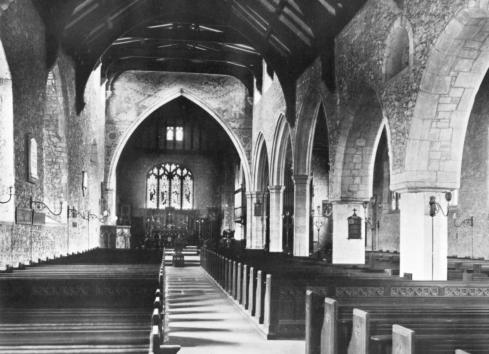Prittlewell Church
The
Church
of
St.
Mary
the
Virgin,
built
of
Kentish
rag
stone,
is
one
of
the
largest
and,
from
an
architectural
point
of
view,
one
of
the
most
interesting
in
the
county.
There
has
been
a
church
on
the
site
of
St.
Mary’s
for
more
than
a
thousand
years.
There
is
archaeological
evidence
that
a
small
chapel
was
erected
on
the
site
of
the
present
church
in
the
7th
century.
A
portion
of
the
Saxon
doorway
of
that
tiny
chapel
remains
today
as
part
of
the
north
wall
of
the
chancel.
The
Norman
nave
was
built
in
the
11th
century,
which
greatly
increased
the
size
of
the
building,
and
the
chancel
of
the
new
church
was
built
over
the
foundations
of
the
original
Saxon
chapel.
St.
Mary’s
Prittlewell
is
mentioned
on
the
Domesday
Survey
of
1086.
A
processional
aisle
was
added
to
the
south
side
of
the
nave
towards
the
end
of
the
12th
century.
Further
additions
were
made
during
the
15th
century,
namely
the
construction
of
the
stately
embattled
tower
(with
pinnacles
and
containing
a
clock
and
bells),
a
south
porch,
(above
which
is
a
parvise
chamber),
an
eastern
wall
that
now
forms
part
of
the
Jesus
Chapel,
and
the
enlargement
of
the
south
aisle
which
almost
doubled
the
size
of
the
church.
When
you
step
inside
this
stunning
church
the
different
styles
of
architecture
are
very
much
evident.
The
pulpit
is
of
Caen
stone,
enriched
with
marble
shafts,
the
central
panel
containing
a
bas-relief.
The
font
is
of
an
octagonal
shape
with
concave
sides
two
of
which
are
blank
but
the
other
six
contain
the
following
Tudor
devices:
a
heart
transfixed
by
two
spears,
a
shield
bearing
a
chevron
between
three
fleur-de-lis,
a
mutilated
crucifix,
the
Tudor
rose
and
Aragon
pomegranate
dimidiated,
a
Tudor
rose
in
a
pentagon
(this
is
an
uncommon
type),
and
a
small
rose.
The
font
is
supported
by
a
square
shaft.
St
Mary’s
also
boasts
of
eight
beautiful
stained
glass
windows
which
include
a
memorial
window
to
Sir
Arundell
Neave
bart.
d.
21
Sept.
1877,
consisting
of
antique
15th
century
Flemish
and Italian glass brought from a church in Rouen and attributed to Albert Durer.
The
Jesus
chapel
was
restored
in
1916
as
a
memorial
to
Canon
Reay
who
was
the
vicar
from
1880-1914.
The
porch
was
restored
in
1921-22
with
the
windows
being
unblocked,
and
stained
memorial
windows
depicting
St.
Michael,
St.
George,
Sir
Galahad
and
King
Arthur
inserted.
In
1922
a
memorial
cross
to
those
who
fell
in
the
Great
War,
1914-18,
was
erected
in
front
of
the
tower.
The
tower
was
restored
in
1924-25,
at
a
cost
of
£2,500.
The
churchyard
was
closed
for
burials
by
various
orders
from
March,
1869,
to
Nov.
1881.
The
register
of
baptisms
dates
from
1649;
of
marriages
and
burials from 1645.
Over
the
centuries
the
church
at
Prittlewell
has
seen
joyous
times,
and
has
fallen
on
hard
times.
Shortly
after
Henry
VIII’s
reign,
at
the
time
of
the
Reformation,
so
much
of
the
church’s
income
and
assets
were
seized
that
the
churchwardens
sold
the
church
plate
to
‘pay
for
maintenance
of
the
church’.
During
the
Second
World
War
St
Mary’s
suffered
blast
damage
from
bombs
falling
nearby,
but
daily
services
continued
throughout
those
difficult
years.
It
is
said
that
the
Vicar
at
that
time,
(Canon
Ellis
Gowing),
had
the
valuable
16th
century
stained
glass
window
removed
from
the Jesus Chapel and buried in the cellar of the old vicarage!

Southend Timeline Southend-on-Sea © 2009 - 2024. All Rights Reserved



SOUTHEND CITY
Essex
c1900 Prittlewell Church


c1900 The Nave Prittlewell Church

Southend-on-Sea’s No 1 History Website! Documenting The Town & The Townspeople
Now Incorporating The Sea Of Change Website
Website Info:


Chalkwell ▪ Eastwood ▪ Leigh-on-Sea ▪ Prittlewell ▪ Shoeburyness ▪ Southchurch ▪ Thorpe Bay ▪ Westcliff-on-Sea
































































